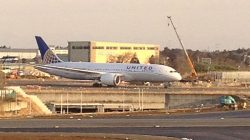The recent network developments in the US-China space have more groundbreaking implications than may appear on paper. A simple rehash of occurrences within the past two weeks provides a good starting framework.
Two weeks ago, Delta Air Lines unveiled plans to launch a nonstop flight from Seattle to Hong Kong.
Last week, United announced a new 787 route from San Francisco to Chengdu, China.
On Tuesday, Hainan Airlines commenced 4-weekly nonstop services from Chicago O’Hare to Beijing, utilizing an Airbus A340-600. The flight is expected to increase to a daily service starting May 31, and will switch to a Boeing 787 in the near future.
Yesterday, The Street reported in an article that for United and the Boeing 787, Chengdu is “just the start” in China. United CEO Jeff Smisek has been saying for the better part of a year now that more changes are on the way.
No doubt, exciting times lie ahead for frequent travelers between the US and China, as well as foreign visitors and tourists who will soon have greater access than ever before to travel between the two nations.
As we speak, parts are shifting within the realm of US-China air services development, and as they evolve, they will continue to be a fascinating topic of interest over the next coming years. Some of the high-level changes will entail:
- Gradual de-emphasis of routing traffic flows via Japan, and to a lesser degree, South Korea
- Shifting growth concentration away from solely focusing on the “big three” Chinese markets: Bejing, Shanghai and Hong Kong, and instead on secondary Chinese cities such as Dalian, Guangzhou, Xiamen, Hangzhou, Shenyang, Wuhan, Xi’an, Chongqing and Nanjing.
- Utilizing the advent of new aircraft, such as the 787 Dreamliner and Airbus A350, to open up routes that would have previously been economically unviable on other long-haul aircraft.
- Continuing to leverage partnerships and codeshares with locally-based airlines and fellow OneWorld, SkyTeam and Star Alliance members.
Japan will be most adversely affected by growth in US-China market
Located in an ideal geographic position between North America and the rest of Asia, Japan has always been the largest beneficiary of capturing flows between Canada and the U.S. and the entire North, Southeast and Southwest regions of Asia. It therefore comes as no surprise that all three major alliance carriers have major presences at Tokyo Narita International airport. For the week of September 2, 2013, Star Alliance controls roughly 35.8% of the market share at NRT, followed by OneWorld at 27.2% and SkyTeam at 20.4%.
However, good geography doesn’t always correlate to long-term strategic importance. Unfavorable conditions in Japan have taken their tolls on the performances of the Japanese markets for North American airlines. Across the board, the four major US carriers operating services to Japan (United, Delta, American and Hawaiian) all reported lagging transpacific financial results for Q2 2013 due to the weakened Yen and diminished rates of corporate travel.
2011 in particular served as a huge wake-up call for US airlines when the Japanese earthquake struck in March of that year. At the time, roughly two thirds of American’s transpacific network was concentrated on Tokyo, and the carrier was forced to suspend some operations for a brief period of time to Narita and Haneda airports in midst of a recovery procedure.
In an effort to curtail some bleeding, network rationalizations in US-Japan have already been announced, with further tweaks a real possibility. Delta is cancelling its nonstop Seattle to Osaka flight, and moving its Detroit – Tokyo Haneda flight to depart from Seattle instead of the motor city. American is reducing frequency on its Chicago O’Hare to Tokyo route later this winter. United is cancelling its very legacy Tokyo to Hong Kong service, and is replacing the 777s used on its San Fransisco – Osaka, LAX-Narita and Seattle-Narita flights with 787s to improve the economics on these routes.
Although Tokyo in and of itself represents a large and fairly high-yielding global O&D market, these network adjustments are likely the earliest signs of a gradual de-prioritization of creating Japan-centric transpacific operations to fifth-freedom destinations in mainland China, Taiwan and Korea for US carriers.
Of course, the changes will likely not be completely dramatic; as I reported two months ago in my post assessing Delta’s future brand and network growth outlook in Asia, certain fifth-freedom markets, such as Singapore and Thailand, are too distant to be served viably nonstop by commercial carriers from the mainland US, and as such, these airlines will continue to be reliant on Tokyo as a connecting hub. Others, such as Manila, are too low-yielding, and are dependent on fifth-freedom routing to Japan in order to work.
Hawaiian Airlines is probably the one exception to this logic, obviously due to its geographic positioning in the middle of the Pacific and its strong O&D ties in the Pacific Rim. HA has steadily grown its Asia-Pac network within the past 5-7 years from its Honolulu base, but with some mixed results. The carrier recently announced it was pulling out of Manila, citing poor numbers and high costs of operations.
Of course, Japan also is anchored by the presence of its two local flag carriers, All Nippon Airways (Star Alliance) and Japan Airlines (OneWorld), who will continue to provide important feeder traffic to smaller points beyond Tokyo through their partnerships with fellow member carriers serving Narita and Haneda airports.
Looking beyond the big three, there is enormous potential in China
The new United route to Chengdu is ground-breaking in that it will be the first North American carrier to serve a Chinese city that is not Beijing, Shanghai nor Hong Kong.
Interestingly, European carriers have been much more proactive about launching secondary Chinese cities in recent years. KLM was the first carrier to launch services to Chengdu in 2006 from its Amsterdam hub, followed by Lufthansa to Nanjing from Frankfurt in 2008. Since then, Air France, Finnair and soon British Airways will all be operating services from their Paris CDG, Helsinki and London Heathrow hubs, respectively, to markets in inner China.
Air France flies nonstop from Paris CDG to Wuhan and Guangzhou, utilizing Boeing 777-200 aircraft. KLM operates services from Amsterdam to Chengdu, Guangzhou, Xiamen and Hangzhou using a mix of Boeing 747-400 and Boeing 777-200 series aircrafts. Finnair operates services from Helsinki to Chongqing and Xi’an using an Airbus A330-300. Lufthansa flies from Frankfurt to Nanjing, Qingdao and Shenyang using Airbus A340-300s, and British Airways will commence services to Chengdu using a 777-200 later this month.
There is a fairly impressive level of service to non-core cities in China, which further underscores their burgeoning importances as locales with 6-10 million inhabitants. On the flip side, market share breakdown among Chinese carriers serving Europe-China tend to be heavily weighted towards flag carrier Air China, which is government-owned and, being based in Beijing, tends to receive favoritism from the regulatory bodies in terms of opening up new intercontinental routes. Still, however, the other two government-owned carriers, China Southern and China Eastern, as well as newer, privately-owned operators such as Sichuan Airlines, Xiamen Airlines and Hainan Airlines, have plans to further grow their long-haul networks after receiving new aircraft deliveries in the near future.
However, returning to the Europe to China vs. US to China comparison, the interesting factoid is that European carriers have stuck to a model of serving these foreign cities on a 3-4 weekly basis using smaller-density seating aircraft. In other words, the formula has proven to be that more can be accomplished with less by deploying aircraft with the right number of frequencies and the right amount of seating capacity to drive up yields on such routes.
So why have North American carriers lagged behind their European counter parts in this space? For starters, geography is a major factor: some of the inland cities in China can be reached capably by medium-range aircraft from hubs like Helsinki. From the US, however, operational freedom is more limited.
Secondly, North American carriers have been much more focused on receiving slot awards to restricted airports such as Beijing, Shanghai and Guangzhou over the past decade. Equally, if not more important, achieving stability in the volatile Asian markets has been a high concern. Eight years ago, United, American, Delta and (pre-merger) Northwest Airlines and Continental were desperate to receive coveted awards from the US DOT to enter the restricted US-China market.
However, market conditions have proven to be tougher than imagined. Delta has entered and exited the Atlanta to Shanghai nonstop market twice before accepting that the route is simply economically unviable given the high operating costs. American had to delay the start-up of its Chicago to Bejing flight a full year before launch in 2010 (although not without significant drama) and still is suffering from poor arrival and landing slot times at Peking, driving down margins and yields. United has struggled to sustain its “capital to capital” flight from Washington Dulles to Beijing year-round, and is sitting on a dormant pair of landing slots to operate San Francisco to Guangzhou.
United will have a huge edge with the 787 and its San Fransisco hub
The inertia from US airlines expanding in mainland China will change significantly with United’s possession of the 787. San Fransisco is, and will continue to be, United’s primary transpacific gateway. Of the three major US carriers, including rival carriers Delta and American, United has the enviable position of leading market share in the transpacific US-Asia/Oceania sector. In many ways, United in San Fransico is to Asia-Pac as American in Miami is to Latin America: strong origin and destination (O&D) levels, high-yielding mix of business and leisure/visiting friends and relatives traffic, optimal geographic positioning to capture connecting passenger flows, and tons of tourism draws.
Reciprocally, Chinese-oriented travelers will also be drawn to faster connections to reach the mainland US over connecting via more congested hubs in other airports across North Asia. Interestingly, Chinese carriers, despite being government-owned, have also been sluggish in opening up new routes to Asia. The typical approach has been to serve coastal cities such as Seattle, San Francisco, Los Angeles and New York, although Air China recently took on a new venture launching a nonstop service to Houston.
Partnerships will be critical for SkyTeam and OneWorld to keep up with Star in China
American and Delta are less concerned about opening up non-core cities in China, mostly due to lack of fuel-efficient aircraft that can capably serve these routes without sustaining major losses. Delta has openly brushed aside the need to serve smaller Chinese cities, citing that its primary focus is to stabliize its existing operations, build up a sizable transpacific gateway at Seattle, and rely on local SkyTeam partners to fill the rest of the void.
American, however, is most disadvantaged in Asia, lacking a suitable transpacific gateway hub to capture North America – Pacific flows. Of its cornerstone hubs in Miami, Dallas/Ft. Worth, New York JFK and Chicago O’Hare, none are ideally suited as a springboard for Asia. Competition from foreign carriers is overly saturated at New York and Los Angeles, and Dallas/Ft. Worth and Miami are geographically too far inland to support a robust Asian network aside from Japan, although AA has been experimental in recently launching a new DFW-Seoul, South Korea daily nonstop. A possible Miami – Tokyo flight has been rumored, but its likely the only nonstop Asian market that Miami could support.
Prior to the 2008 financial meltdown, Chicago was originally intended to serve as AA’s primary AAsia gateway, but that strategy has largely been a major flop. AA exited the nonstop Chicago-Nagoya market fairly quickly, and has struggled with its Chicago-Shanghai and Beijing flights since inception. While OneWorld partners JAL and Cathay Pacific serve O’Hare nonstop from Tokyo and Hong Kong, respectively, not much else appears to be in the pipeline to further strengthen OneWorld’s presence from the Midwest to Asia.
Hainan, however, is code-sharing with AA on its new Chicago to Beijing flight, which could serve as a promising sign for future OneWorld growth in mainland China. American badly needs a local partner in the PRC, something that Delta and United have through their SkyTeam and Star Alliance partners. American and OneWorld is bolstered by the transatlantic JV with Japan Airlines via Tokyo, and the latter carrier has been proactive about launching new thin routes on the 787, with recent expansion into Boston and San Diego from Narita.
However, this is not enough to cover the important Chinese market. While Cathay Pacific is a strong player in Asia, its geography in Hong Kong involves significant back-tracking to reach interior China. Moreover, Cathay’s relationship with OneWorld is fairly lukewarm, and the concept of a transpacific JV is likely out of the picture in the near term. Ideas have been kicked around to launch a nonstop Dallas/Ft. Worth – Hong Kong flight in the near future, which would be a huge boon to both American and Cathay to connect massive hubs on either end. However, Cathay’s recent announcement to add a 5th daily service to the New York region, via Newark this time, serves as another indication that the carrier prefers to cling to a conservative network growth strategy, targeting high O&D markets rather than tapping into unserved OneWorld hubs to pounce on connecting traffic.
Overall: Asia is volatile, but cannot be ignored
Asia has not been a panacea for US airlines, but its importance cannot be overlooked. Expansion into key markets is critical, if executed properly.
The gold rush to gain slots at Beijing and Tokyo Haneda airports paints a picture of profit-hungry US airlines desperate to flex their muscles and capture market share, only to be disappointed with mixed results. American, in particular, has been beleagured by the inconvenient arrival and departure times at both of these airports from a P&L standpoint.
Nevertheless, the fight will go on. Delta CEO Richard Anderson is imploring the Japanese government to allow Delta to move its operations from Narita to Haneda airport, asking for an allocation of 25 landing slots. Delta is also trying to seek a partnership with Japanese carrier Skymark, and also has cooled its relations with fellow SkyTeam founder and partner carrier Korean Air through a recent codeshare drop. Overall, almost too many shifting gears to keep track of, but understandably, Delta is just trying to keep pace with the times and protect its interests in Asia.
All the meanwhile, the US-China market will continue to grow as visa processing improves, allowing for rising traffic levels. So at least the outlook there is good. The only challenge, for both US and Chinese carriers alike, will be to not only play cards, but to play them correctly in order to walk away with deeper pockets.
My guess is that so far, United emerges as the clear victor in the lead, but time will tell who forges ahead, and who is left in the dust.



